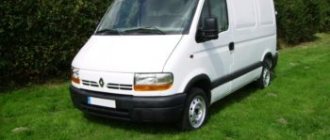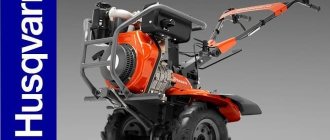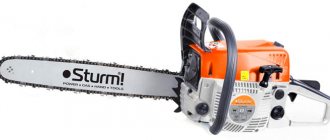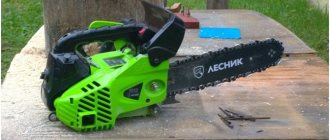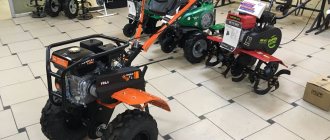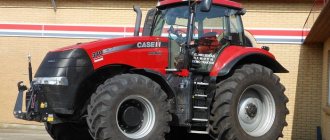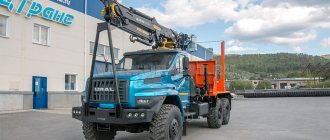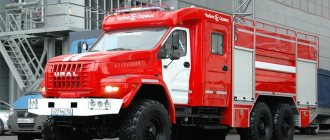Choosing a car is a responsible process. And if we are talking about a cargo truck, then it is doubly serious. For heavy truck drivers, a car is a second home and it is very important that this “home” is reliable and comfortable.
Truck manufacturers offer hundreds of models, differing not only in size, but also in additional options. The article will talk about one of the leading companies producing special equipment -. Let's look at the advantages of trucks, interior features and talk about the most popular tractor models in Russia.
About the manufacturer
Freight car .
Ford is one of the very first companies to appear on the automotive market. It began in 1896, when the famous inventor and businessman Henry Ford designed a car that became a legend.
Another turning point for the company would be back in 1932. It was then that mass production of V-shaped eight-cylinder engines was launched.
The Henry plant was the first to produce a monolithic 8-cylinder block. The company confidently became a market leader, and car assembly plants were opened.
Today, Ford production facilities operate in 30 countries. Millions of cars – trucks, cars, tractors – come out of factory assembly lines every year. The company has shares in several brands, but cars under the “name” Ford remain a confident leader both in Europe and on the world market.
Sixth generation (1973-1979)
1973 Ford F-100
In the first half of the 70s, a real boom among pickup trucks began in the USA. Several powerful advertising campaigns were broadcast on TV and the print press, which finally convinced Americans that a pickup truck is the ideal car for every day. However, this was partly true; by the sixth generation, F-series cars had become even more comfortable and versatile.
The new cars were still based on the chassis from the fourth generation model, but it was significantly modernized. Ford engineers increased the width of the rear track to match the front, installed disc brakes at the front, and moved the gas tank from the rear wall of the cab to the frame. Thanks to this solution, it was possible to provide an optimal backrest angle and greater legroom. In addition, the rear springs were lengthened, making the suspension a little softer.
Ford F-100 SuperCab
The design was also maintained in the usual straightforward style, but became more angular and sharp. A wide molding appeared on the sidewall with direction indicators inscribed in it. But most importantly, the cabin and body have now become more resistant to corrosion. All thanks to improved processing of welds and the use of galvanized steel. In 1974, for the first time in the series, an extended, 6-passenger, two-door “SuperCab” cab became available. A year later, a new Ford F-150 model appeared.
1977 Ford F-150
The Ford F-150, with a gross weight of 2,700 to 2,950 kg depending on the modification, formally belonged to the class of heavy trucks. At the height of the gasoline crisis , more tolerant environmental standards were in effect in this class, so the Ford F-150 could quite easily consume cheaper leaded gasoline, since it completely lacked a catalyst. Of course, the F-150 didn’t get heavier out of nowhere. It used a reinforced frame and front suspension with stiffer springs. I must say that Ford’s trick worked perfectly and the Ford F-150 quickly became a sales leader. That year alone, the company managed to sell 723 thousand pickup trucks. Moreover, the F-150 was produced the most - 337 thousand. But that was only the beginning!
General characteristics of Ford trucks
What attracts famous cars? Comfort has become one of the main components of success. The interior of the tractors is thought out to the smallest detail. Manufacturers rely not only on comfort, but also on the power of trucks.
The engines captivate drivers with their balance of efficiency and performance. The pride of the company is the Ecotorq diesel engine. Engineers worked on its development for 10 years! Now the trucks can boast an engine capacity of 7.33 liters. Power – 240 and 300 l. With.
In addition, the new generation Ford truck is equipped with an EDS system. This system monitors almost all moments in the operation of the equipment, from the pressure of the driver’s foot on the gas pedal to the air temperature outside.
Purpose and benefits
Ford special equipment is used for agricultural needs, work on construction sites and, of course, in the field of cargo transportation. In addition to the comfortable interior, the engineers have thoroughly thought through the security system.
The trucks are suitable for Russian roads, equipped with an anti-rollover system and are easy to maintain. The cost of spare parts is quite reasonable, and you can find them in almost any specialized store.
Design Features
The company, which has factories in dozens of countries, adapts equipment to local consumers. An American Ford and a Turkish car may differ in a number of parameters. However, in the main points the trucks are similar.
The brand's tractors are characterized by powerful power plants of considerable volume, as well as spacious cabins for drivers. The design of the trucks allows them to be driven off-road without fear of damaging bridges.
Specifications
Climate control of a Ford truck.
Each Ford vehicle is equipped with a climate control system and air conditioning.
Spacious sleeping areas and an abundance of equipment in the driver’s cabin make the cars real “homes on wheels.” The Ford truck is adapted for areas with severe winter conditions.
All main components of the engine and fuel supply system are covered with heat shields. This feature ensures safe operation in cold weather. The installation of additional elements responsible for heating the fuel tank and lines is also provided. All equipment falls under the European standards EURO 5.
Third generation (1957-1960)
Ford F-100 Flareside
The third generation pickup trucks, which appeared in 1956, can be distinguished from their predecessors by their radically different appearance. The new EFKs received rectilinear-style cabins with an integrated tail. The cabin itself has become wider and more spacious, however, the minimum wheelbase of the Ford F-100 has not changed and remains 2794 mm. But the design of the onboard platform has changed. In addition to the traditional rectangular cargo compartment fitted between the wheel arches (“Flareside”), they began to offer a body with flat sidewalls and wheel arches integrated into them (“Styleside”). In 1958, the front fascia was slightly updated by adding four-headlights.
Flatbed Ford F-100 Styleside
Since 1959, instead of the 4.5-liter engine, a new 4.8-liter V8 with a capacity of 186 hp began to be installed. But most importantly, for the first time among its competitors, Ford began installing all-wheel drive transmission on its light pickups. It was designed according to the classic design - with a plug-in front axle and a two-speed transfer case.
The lineup
The Ford line includes classic tractors, trucks with different wheelbases and different numbers of axles. In the Russian Federation, several variants of trucks have become most popular. Let's take a closer look at them.
Ford F-Max
Photos of this model spread all over the world. And deservedly so: the vehicle became the winner of the “Truck of the Year 2019” competition. The total weight of the tractor is 18 tons. The car has a 12.7-liter six-cylinder Ecotorc engine. Its power is 500 hp. With.
The driver's seat of the truck is equipped with heating and lumbar support. From the display, the driver will be able to monitor the condition of the brake pads, the load on the axles, and the level of the frame when coupling. There, by pressing a couple of combinations, you get all the information about the car.
The truck is equipped with a high sleeper cab with air suspension. The cabin width is 2.52 meters. You don’t have to think about stopping for snacks on the road: the manufacturer has provided a 38-liter pull-out refrigerator.
Detailed information is visible in the video:
1848T XHR
This model is equipped with an extra-high cab with a single berth. The truck is equipped with air conditioning, radio with Bluetooth, cruise control, EBS and ABS systems. The brake system is disc, there is brake boost control, a brake lining wear sensor, and traction force control. The fuel tank here is designed for 600 liters of diesel.
1833D DC
The cabin of this tractor does not have sleeping places. The equipment is suitable for transporting cargo over short distances. The fuel tank holds 315 liters, the Add blue tank holds 55. Heated external mirrors are provided, and there are fog lights.
The speed that the tractor reaches at maximum is 89 kilometers per hour. The brake system, as in other models, is disc. Allows you to select the rear suspension. It can be spring or air-cushioned. The length of the cabin is 1820 centimeters.
2533 HR
Large-capacity truck, has three axles. The “nose” of the car is decorated with a massive high bumper, large headlights and aerodynamic elements. There is a cruise control system, ABS, tachograph, electronic windows and mirrors. The cabin width is 2540 centimeters. Diesel engine power – 330 hp. With. with a volume of 8.9 liters. The total weight of the tractor is 17.8 tons.
Other models
Ford Transit tractor.
Another model beloved by Russian truckers is the Ford Transit. The tractor is used to transport impressive volumes of cargo.
Engine power – 125 hp. With. Its volume is 2.2 liters, which makes the car quite economical. The manufacturer equipped the driver's seat with heating and provided a cabin heater.
Also in the cabin there are compartments for storing documents, two 12 V sockets.
First Ford F-series (1948-1952)
Ford F-2
In 1947, Ford Motor Company introduced the Ford F-series light trucks. The company had produced vehicles of a similar class before that. However, previously they were, although modified for the transportation of goods, still passenger cars. The F-series cars had specially designed cargo chassis. In total, the line included eight vehicles, from pickups with a carrying capacity of 500-750 kg (models F-1, F-2 and F-3) to full-fledged commercial trucks with a carrying capacity of 1.5 to 3 tons. Buses, fire engines, utility vehicles, and construction vehicles were built on the basis of heavy “effects”. But the lion's share of sales was still made up of light pickups.
A new cabin was developed especially for the F-series, which was unified across the entire model range. In general, Ford spent $1 million on developing the cab and purchasing equipment, which is why it was aptly nicknamed “Million-Dollar Cab.” However, the costs were worth it. The cabin turned out to be much more spacious, more comfortable and with much better visibility than its predecessors. In addition, the cars were already equipped with a glove box, ashtray and sun visor as standard. Optionally, it was possible to install a windshield washer, an additional sun visor and a rear light. Now such equipment will seem spartan, but at that time it was considered very rich. In general, F-series pickups were praised for their high comfort and ease of operation. All thanks to the attachment of the cabin to the frame through rubber dampers and comfortable seats with soft spring padding.
Light F-2 chassis
In technical terms, everything also turned out more than worthy. The machine was based on a durable spar frame. The suspension of all wheels is dependent, on semi-elliptic springs. Drum brakes without booster. The main power unit was not the most advanced, but reliable as a cast iron weight, the lower valve 6-cylinder Ford Flathead L6 engine. With a volume of 3.7 liters it produced 95 hp. Optionally, it was possible to install an 8-cylinder engine, also with a “flat head” with a volume of 4 liters and a power of 100 hp. A 3-speed manual transmission was offered in tandem with the engines, in standard (only for the Ford F-1 model) or reinforced version. For an additional fee, it was possible to order a 4-speed manual transmission. The drive is rear-wheel drive, but a third-party company, Marmon-Herrington, was already in full swing converting the EFKs into all-wheel drive all-terrain vehicles.
Heavy Ford F-4
In general, the first generation Ford F-series trucks turned out to be very successful. They were well tailored and well assembled. They had a comfortable and beautiful looking cabin. Ford managed to create a pickup truck that was not a shame to use both as a work car and as a personal car. This is how the philosophy of the American pickup gradually began to take shape.
Ninth generation (1992-1997)
1992 Ford F-150
The next ninth generation entered production in August 1991. The new product was based on the same chassis as its predecessors; the main changes affected the appearance. Ford began to gradually move away from the rectilinear style, designing cars in accordance with the new rounded fashion. In addition, to the delight of all lovers of the “Flareside” style, the body with curvaceous rear arches has again become available for order.
In 1993, a special modification of the Ford F-150 SVT Lightning went on sale from specialists from Special Vehicle Operations, Ford’s sports division. Lightning could be any color as long as it was black (red and white were later added). This pickup truck could be identified by its body-color grille, bumper with fog lights, original 17-inch aluminum alloy wheels and badges on the front fenders. Under the hood was a forced Windsor V8 with a volume of 5.8 liters and a power of 240 hp. In addition to the engine, specialists upgraded the suspension and automatic transmission. As a result, the Lightning handled fairly well, and accelerated to 60 mph in 7 seconds, and this despite the fact that the pickup was rear-wheel drive. All-wheel drive was not offered for it even as an option. Due to its agility, the “charged” pickup truck received the nickname “Mustang GT with a cargo bed.”
1993 F-150 SVT Lightning
In 1994, engineers carried out serious work to improve safety. A driver's airbag now comes standard on all F-Series light-duty pickups. In addition, safety bars were installed in the side doors.
Surprisingly, by 1996, the F Series still held the title of the most popular pickup truck in the United States. That year they sold 780 thousand units! But this was not yet a record.
Ford F-150 - America's premier car
Since 1977, F-Series pickups have been the most popular vehicles in their class, and since 1981, the most popular vehicles in America overall. Their success is based on a competent marketing policy, frequent updates and progressive improvement. In fact, it was Ford who transferred Americans to pickup trucks. From its inception to the present, the corporation has managed to sell more than 40 million F-series pickups, the lion's share of which was the Ford F-150. In general, Ford people have never admitted this, but according to experts, 90% of the corporation's profits come from pickup trucks. This is not surprising since on average Ford has 25% net profit from one F-150, while from a passenger Ford Mustang no more than 10%. Thus, it becomes obvious that the development priority of the corporation’s automotive division will constantly shift towards pickup trucks and commercial vehicles. Actually, this has already happened, you just have to look at the current model range of the American company.
Tenth generation (1997-2003)
1997 Ford F-250
The debut of the tenth generation anniversary took place in 1995. Yes, despite the fact that the model was officially assigned to the 1997 model year, it was produced in a small series for two years. However, we are only talking about the Ford F-150 and F-250; the heavier ninth-generation cars continued to be produced without changes. The fact is that Ford marketers decided to divide the F-series into two branches: light, which included the F-150 and lightweight F-250, and Super Duty, which included all the others - essentially commercial vehicles.
The new pickup trucks have undergone fundamental changes both inside and out. In essence, this was the most radical update in the entire history of the series. By releasing such revolutionary cars, Ford took a big risk. But the risk paid off and the Americans greeted the tenth generation of the Ford F-150 quite favorably, and in the first year alone, dealers sold 248 thousand cars.
1998 Ford F-150
One of the most significant changes is the updated appearance. The new F-150 adopts a rounded “aero design” in the style of the recent second-generation Ford Taurus. The pickup truck has slightly increased in size, which also has a positive effect on the interior volume. In terms of equipment in the maximum configuration, the Ford F-150 has long been on par with mid-high-class passenger cars. Thus, the new generation model was equipped with a premium stereo system with a 6-disc changer, electric seats and mirrors, cruise control, a light sensor and, of course, air conditioning. For those who weren't satisfied with this, they could purchase a top-class five-door full-size SUV - the Lincoln Navigator, which was also built on the F-150 platform.
Ford F-150 NASCAR
The platform itself has also undergone significant modernization. The Twin-Beam front independent suspension was retired. Instead, a spring suspension was installed on wishbones. In addition, the range of engines has been completely updated. Instead of the inline six that faithfully served the F-Series for 32 years, a new V6 with 205 hp came. At the top of the hierarchy was the 5.4-liter Triton V-8 with 235 hp. In 1998, Ford introduced the limited-edition Ford F-150 NASCAR. Its body and wheels were painted black, and on the sides of the body near the very edge there were checkered flag colored liveries. The pickup truck was produced in honor of the 50th anniversary of America's main auto race - NASCAR, in the amount of 3 thousand units. Under the hood was a 4.6-liter Triton V-8 producing 220 hp, which was paired with a 5-speed manual or 4-speed automatic. Rear-wheel drive only, no 4WD.
2003 Ford F-150 SVT Lightning
A famous event in 1999 was the return of the “charged” modification of the SVT Lightning. The 1999 Ford F-150 SVT Lightning was available in a single two-door cab with rear-wheel drive. A V8 engine with a 5.4-liter displacement and a power of 360 hp was placed under the hood. With this engine, a 2.5-ton pickup accelerated from 0 to 60 miles in just 6.2 seconds. The maximum speed was 225 km/h, and the Lightning covered a quarter mile in 14.6 seconds, exactly the same result as the 2002 Ford Focus RS. Externally, the sports pickup truck could be identified by its bright colors in one of three colors - red, white or black, lowered suspension, sports body kit and original 18-inch wheels.
2003 Harley-Davidson Ford F-150
Meanwhile, the SVT Lightning wasn't the only exclusive tenth-generation F-150. In 2002, as a result of a collaboration between Ford and the well-known motorcycle company Harley-Davidson, a special modification was released - the Harley-Davidson F-150. Under this name was hidden a black pickup truck with a one-and-a-half cab SuperCab. Externally, the car stood out with a chrome-plated radiator grille with vertical slots, Harley-Davidson nameplates and five-spoke alloy wheels with a diameter of 20 inches. Until this moment, no one in the world had installed such large rims on pickup trucks. In technical terms, the “motorcycle” F-150 also looked very decent. It was equipped with a 5.4-liter Triton V8 engine producing 260 hp, lowered suspension and an SVT exhaust system.
In 2001, for the first time in history, the F-150 received a four-door SuperCrew cab and four-channel ABS. In 2003, the tenth generation Ford F-150 was formally discontinued. However, in fact, the car was produced for another year under the designation F150 Heritage.
